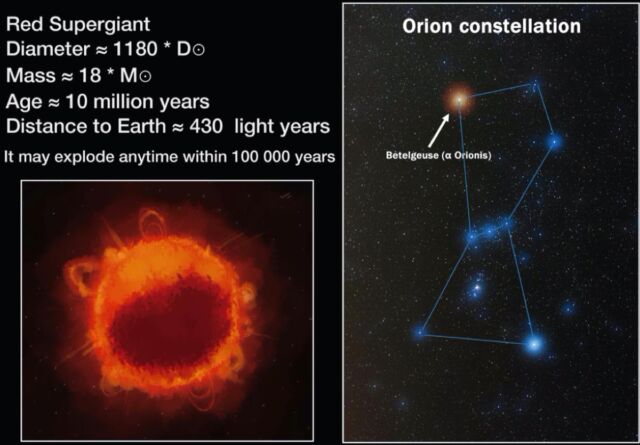Back in June, we reported on a likely explanation for the strange, dramatic dimming of Betelgeuse, a bright red star in the Orion constellation: The star burped out a massive gas bubble, resulting in lower temperatures that condensed heavier elements into dust that temporarily obscured the starlight. Now, a team of Chinese scientists has found evidence of a large, dark, cooler spot on the star—consistent with those earlier findings—based on spectral analysis, according to a recent paper published in the journal Nature Communications.
As Ars' John Timmer reported last year, Betelgeuse is one of the closest massive stars to Earth, about 700 light-years away. It's an old star that has reached the stage where it glows a dull red and expands, with the hot core only having a tenuous gravitational grip on its outer layers. The star has something akin to a heartbeat, albeit an extremely slow and irregular one. Over time, the star cycles through periods when its surface expands and then contracts.
Astronomers noticed the pronounced dimming of the light from Betelgeuse in December 2019; the difference was even visible to the naked eye. And the dimming persisted, decreasing in brightness by 35 percent in mid-February before brightening again in April 2020. Astronomers puzzled over the phenomenon and wondered whether it was a sign that the star was about to go supernova.
Telescopes pointed at the giant were able to determine that—rather than a tidy, uniform drop in luminance—Betelgeuse's dimming was unevenly distributed, giving the star an odd, squished shape when viewed from Earth. UV data from the Hubble Space Telescope, combined with some timely ground observations, also indicated that a big burp formed a cloud of dust near the star. Those findings helped scientists narrow the most likely explanations down to two: a short-lived cold patch on the star's southern surface (akin to a sunspot) or a clump of dust making the star seem dimmer to observers on Earth.
The authors of the June paper in Nature concluded that dust was the primary culprit, but the dust is linked to the brief emergence of a cold spot. As revealed by images captured by the European Southern Observatory's (ESO) Very Large Telescope (VLT) in January and March 2020, a gas bubble was ejected and pushed further out by the star's outward pulsation.
When a convection-driven cold patch appeared on the surface, the local temperature decrease was sufficient to condense the heavier elements (like silicon) into solid dust, forming a veil that obscured the star's brightness in its southern hemisphere. The astronomers speculated that a similar expelling of dust from cool stars could provide the building blocks for new planets.

In this latest paper, scientists at the National Astronomical Observatories of the Chinese Academy of Sciences (NAOC) decided to take a closer look at the star's spectra in the near-infrared wavelength based on observations gleaned from the Weihai Observatory of Shanghai over the course of the dimming period. To do so, the team developed a new technique for determining the effective temperatures of red supergiants like Betelgeuse.
"Our method is based on the measurement of titanium oxide (TiO) and cyanide (CN) molecular lines in stellar spectra," said co-author Sofya Alexeeva of NAOC. "The cooler a star is, the more these molecules can form and survive in its atmosphere, and the molecular lines are stronger in the stellar spectrum. In a hotter atmosphere, these molecules dissociate easily and do not survive."
That analysis revealed a dramatic cooling during the dimming period of about 170 Kelvin, from 3646 K (6103 F) to 3476 K (5797 F), which the authors attribute to large convective cells forming on the stellar surface. Alexeeva et al. suggest that this cooling was likely confined to a large dark spot, as opposed to the entire star cooling down. The models proposed in the two papers, published two months apart, are not in conflict when it comes to how much Betelgeuse cooled, and they only differ in how strongly they each rate the role of dust in the dimming.



3175x175(CURRENT).thumb.jpg.b05acc060982b36f5891ba728e6d953c.jpg)


Recommended Comments
There are no comments to display.
Join the conversation
You can post now and register later. If you have an account, sign in now to post with your account.
Note: Your post will require moderator approval before it will be visible.